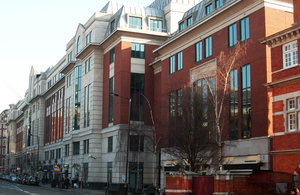New steps to keep HGVs on the right road
New rules laid before Parliament will allow councils to update and introduce new signs without Whitehall agreement.

Ministers are tackling the misery caused by lorry drivers following satnavs down narrow and inappropriate roads as part of a package of new traffic signs rules.
Under the new rules, laid before Parliament by Transport Minister Norman Baker, councils will no longer need Whitehall approval to introduce certain new signs or some existing ones that they need to use on a regular basis - including one to warn lorry drivers of unsuitable roads.
The government believes the changes will cut bureaucracy and give councils the flexibility to make sure their roads reflect the reality of modern driving and cycling.
Among the new signs councils will now be able to use without needing to get government approval are those indicating that a route is unsuitable for lorries - designed to tackle the problem of lorry drivers using inappropriate roads because they are following satnavs and signs indicating charging points for low emission vehicles.
Norman Baker said:
I am bringing an end to the ludicrous situation where councils have to come to central government for permission to put up signs they need to use on a regular basis to manage their roads.
This will also allow them to more easily introduce new signs - like those which will prevent satnavs directing huge lorries down narrow country lanes.
By adding these signs to the list of those which councils can use without needing Whitehall approval we will be reducing costs and bureaucracy as well making sure that the needs of 21st century drivers and cyclists are met.
Currently councils must either use signs authorised in the Traffic Signs Regulations and General Directions (2002) or gain specific approval from the Department for Transport. The changes being put forward will add more signs to the Traffic Signs Regulations and General Directions so that councils can use them without gaining specific approval. This measure - taken forward as a result of the traffic signs policy review - will reduce costs and bureaucracy for local councils and cut the number of authorisations the department needs to process by around one third.
The signs which will be added to the list of those which councils can use without government approval include those indicating:
- routes which are unsuitable for heavy goods vehicles. To reduce the problems caused by drivers following satellite navigation systems down narrow roads, a new information sign has been authorised for use warning of roads which are unsuitable for lorries
- dedicated parking bays for car club vehicles and electric vehicle charging points
- that contra-flow cycling is permitted on one-way roads without councils needing to put in place expensive traffic engineering. This allows cyclists to use quieter side roads rather than busier main routes and follows trials across London
- timings for cycle routes. Councils will now be able to make cycle routes more user-friendly by putting up signs showing how long it will take to reach a destination on a cycle route rather than just showing the distance
- available headroom warnings. Currently, councils wanting to indicate headroom warnings in metric and imperial measurements must use two separate signs. From now on councils will be able to use one sign showing both measurements, reducing clutter and cutting costs. Councils will still be able to use a single sign displaying imperial units only
- roads where toads may be crossing the carriageway. Toads on the carriageway can present a skid risk to drivers and signs warning drivers that toads may be on the road are currently allowed to be used from February to May. To allow for the effect of climate change on toad migration, councils can put the warning sign in place a month earlier without needing to gain approval
- restricted parking zones and permit parking areas
Other changes include:
- allowing Highways Agency traffic officers additional powers to direct traffic on the motorway and trunk road network. This will free up police resources and reduce the time it takes to get traffic moving after an incident
- councils will no longer be able to put in place signs using the phrase ‘Nearly Full’ to describe availability at car parks. Instead, local authorities will be able to display the number of spaces available at any one time, providing clearer, more useful information to motorists looking for somewhere to park
- giving councils greater flexibility on the number of repeater signs they use to help reduce costs and clutter. Councils will still need to have at least one repeater sign after a specified threshold in any zone or limit but will have greater responsibility for deciding on the appropriate level of repeater signing after that point
The statutory instrument outlining the changes to the traffic signs regulations and general directions is expected to take effect from 30 January 2012.
Further information
Images of the signs are available on request.
The department published its report on the traffic signs policy review ‘Signing the Way’ in October. The review sets out a new framework for traffic signing in Great Britain which, whilst maintaining consistency, will provide more flexibility for local authorities to deliver signing appropriate to the environment.
Highways Agency traffic officers will be given powers to direct traffic while carrying out their incident management duties. This includes being able to direct traffic:
- to cross double white lines
- to stop within a controlled area indicated by zig-zag lines
- to pass lane closure light signals (to diagram 6031.1) on motorways and all-purpose dual carriageway roads
- to stop within a bus stop clearway
Roads media enquiries
Media enquiries 0300 7777 878
Switchboard 0300 330 3000